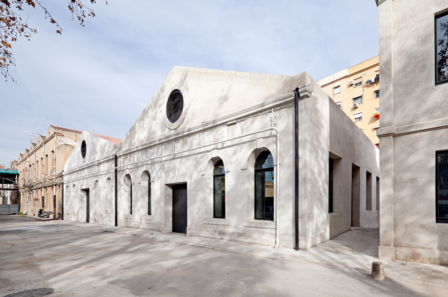History
1997 and Before: The Beginnings
As early as 1993, the shortage of workspaces for artists was a ongoing complaint of the Associació d’Artistes Visuals de Catalunya (Association of Visual Artists of Catalonia, or AAVC). While the city of Barcelona was seeing the development of plenty of spaces for the display of artwork– MACBA, Virreina, Fundació Antononi Tapies, and Centre d’Art Santa Mònica–, there still was no support structure for artistic production, nor physical space dedicated to generating art for these new places.
In mid-1996, after searching various spaces in the city, the AAVC decided to rent the old textile factory of Marqués de Santa Isabel, situated on the street of the same name, in the neighborhood of Poblenou in Barcelona. The original idea of an artistic workspace was expanded into the creation of a resource center for artistic production. The refurbishment project of the building was made the architect Mirco Meyetta. On June 20, 1997, Hangar opened its doors.
1998 – 2002: A Conceptual shift: Focusing on Multimedia and Net Art
Under the direction of the Florenci Guntín, and with the especially active involvement of Kònic Thtr, a collective that works with dance and interactive media, Hangar began to focus increasingly on the production and post-production of multimedia projects. This led to the creation of Hangar’s Medialab (currently the digital image laboratory and the interaction laboratory). To give artists the technological skills to complete their own work, various seminars about software and hardware were held to train artists in editing and programming techniques for the production of sound, video and interactive systems.
Hangar was also one of the first cultural centers to create a net art archive, beginning the project in 1998.
2002- 2005: The AAVC Private Foundation
In 2002, the AAVC Private Foundation was founded, giving Hangar its legal status. The constitution of the founding equity was made thanks to donations of original works made by various visual artists such as Sergi Aguilar, Frederic Amat, Evru, Luis Gordillo, Joan Hernàndez Pijuan, Robert Llimós, Antoni Muntadas, Perico Pastor, Jaume Plensa, Susana Solano, Antoni Tàpies, Francesc Torres, and prints by Arranz-Bravo, Ràfols CasaMADA, Miguel Condé, Florentino Diaz, DIS Berlin, Jose Luis Fajardo, Jorge Galindo, Teresa Gancedo, Juan Genovés, Montserrat Gomez-Osuna, Josep Guinovart, Sohad Lachiri, Carlos León, Robert Llimós, Daniel Machado, Feli Moreno, Jorge Oteiza, Soledad Sevilla, Manolo quejido, Rafael R.de Rivera, Sergio Sanz, Schlunke, Salvador Victoria, and Carlos Franco. Work by Antoni Abad was also included further on. These are the assets that currently make up the Foundation’s collection.
Also in 2002, Manuel Olveira was appointed director of Hangar, for the first time as a result of an open call. Through the process of experimenting, the center gradually consolidated its activities into its current model of artistic production and diffusion.
Hangar also expanded its network of exchange with other centers of production, and set up its International Exchange Program for resident artists.
2005 – 2009: Open source
Pedro Soler took over from Olveira as director of Hangar in 2005. Through his programme, the expansion of technological support for artists led to the creation of the Interaction Laboratory in addition to the already existing Medialab. In order to provide technical training for artists to use these tools,in 2006 Hangar together with the AAVC started the Lifelong Learning Program for visual artists.
Hangar continued to expand and strengthen its links with the immediate environment, specially with the residents associations and with other art spaces in Poblenou such as El Niu, and co-producing exhibitions with other centers in the city such as Ars Santa Monica and MACBA.
2010 – 2017: A New Area of Artistic R+D+I
In 2009, there was a new open call for the direction of the centre, and Tere Badia was appointed director of Hangar. A new department of Research and Development was set up as a result of the prospect of making space within the centre for pre-production, production, and post-production processes in the visual arts. The objective of this new department is to promote art research and generate a favourable environment for the cross-sector transmission of knowledge. At the same time, new alliances are being made with experimental collectives, universities, research centres, and other organisations and programmes whose share Hangar’s objectives, methods and contents.
Also in 2009, work on Hangar’s extension and renovation began. The new buildings include a new sound stage, a well-equipped space for the various technical and technological labs, and an artist residency, which consolidates and diversifies Hangar’s residency programme.

